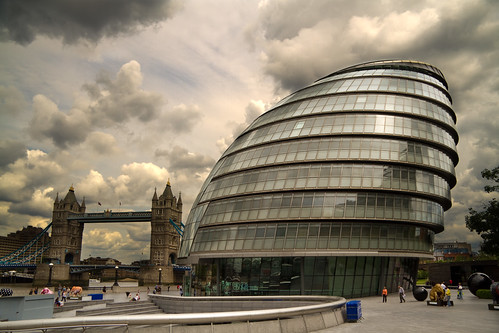After Parliament and the Supreme Court we visited Inns of the Court, a collection of legal encampments where students live, study and intern at law firms that are headquartered within the Inns. The Inns were originally created just outside the city walls, or “bar”, which is where the term Bar and Barister originated. There are a number of Inns, the most famous to us Commoners would be the Temple Inn, home of the Knights of Templar and location for a significant clue in “The DaVinci Code.”
We toured the Royal Courts of Justice – the Appellate Court was closed, but we were able to sit in on a portion of a hearing involving closing arguments in an estate challenge. The Baristers were in robes and wigs, though the Judge was wearing his own hair.
After a pub lunch we traveled to London’s city center and visited the City Hall, a very modern building next to the Tower Bridge. The building was designed by Norman Foster and has a unique circular design of offset layers of floors – one common nickname for the building is the “Leaning Tower of Pizza.”
Inside the City Hall is an enormous floor map of London and its surrounding areas. We were told that London City is only a square mile in area, but “if you look you can see that it isn’t really square at all.” In other math related news, we were also told that Norman Foster’s other building in London (affectionately known as “The Gerkin” because of its resemblance to a giant standing pickle) “is as wide as it is tall, though it looks much taller than that.” In fact, its height is roughly equivalent to its circumference, not its width, making it three times taller than it is ‘wide’. Width, I suppose, is a difficult concept for some to get their arms around.

